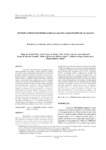Use este identificador para citar ou linkar para este item:
http://www.alice.cnptia.embrapa.br/alice/handle/doc/943206| Título: | Atividade residual de herbicidas usados na soja sobre o girassol cultivado em sucessão. |
| Autoria: | DAN, H. de A.  DAN, L. G. de M.   BARROSO, A. L. de L.   PROCOPIO, S. de O.   OLIVEIRA, JÚNIOR, R. S. de   BRAZ, G. B. P.   ALONSO, D. G.   |
| Afiliação: | HUGO DE ALMEIDA DAN, IFRO - Colorado do Oeste, RO; LILIAN GOMES DE MORAES DAN, UEM; ALBERTO LEÃO DE LEMOS BARROSO, FESURV; SERGIO DE OLIVEIRA PROCOPIO, CNPSO; RUBEM SILVÉRIO DE OLIVEIRA JÚNIOR, UEM; GUILHERME BRAGA PEREIRA BRAZ, UEM; DIEGO GONÇALVES ALONSO, UEM. |
| Ano de publicação: | 2012 |
| Referência: | Ciência Rural, Santa Maria, v. 42, n. 11, p. 1929-1935, nov. 2012. |
| Conteúdo: | RESUMO: O girassol é uma oleaginosa de destaque entre as culturas utilizadas em sucessão à soja na região dos cerrados. No entanto, poucas informações referentes aos efeitos da atividade residual de herbicidas aplicados na soja sobre o desenvolvimento e rendimento do girassol são conhecidas. Visando avaliar a atividade residual de herbicidas, aplicados em pré e pós-emergência na cultura da soja sobre o girassol cultivado em sucessão, foram conduzidos ensaios em campo e em casa de vegetação. No ensaio de campo, foram empregados nove tratamentos (doses em kg de i.a. ha-1): imazaquin (0,161), diclosulam (0,035), sulfentrazone (0,600) e flumioxazin (0,050), em aplicações de pré-emergência, e chlorimuronethyl (0,015), imazethapyr (0,060), imazethapyr (0,100) e fomesafen (0,250), aplicados em pós-emergência da soja, mais uma testemunha (sem herbicida). Um bioensaio foi conduzido em casa de vegetação com as amostras de solo dos tratamentos coletadas em seis épocas distintas (0, 35, 70, 105, 140 e 200 dias após a aplicação). Os resultados permitem concluir que o imazethapyr (0,100kg ha-1) e o diclosulam (0,035kg ha-1) causam redução no rendimento do girassol. A sensibilidade ao diclosulam perdura durante todo o cultivo do girassol. ABSTRACT: Bioactivity of herbicides used to soybean on sunflower crop in succession. The sunflower is a oilseed crop kind of prominence before the cultures used in succession in the Brazil. However, little information concerning the effects of residual activity of herbicides on the crop in this region are known. The aim of this study was to evaluate the residual activity of herbicides in weed management in pre and post-emergence soybean and evaluate its effects on sunflower crop in succession. In field experiments we adopted the randomized block design with four replications, being appointed nine treatments (kg of i.a. ha-1): imazaquin (0.161), diclosulan (0.035), sulfentrazone (0.600) and flumioxazin (0.050) in pre emergence applications, and chlorimuron-ethyl (0.015), imazethapyr (0.060), imazethapyr (0.100) and fomesafen (0.250) applied post emergence soybean and a control without herbicide. One bioassay was differentiated by the treatments contained in each treatment and soil samples collected at six different times (0, 35, 70, 105, 140 and 200 days after application); evaluated the dry matter accumulation of sunflower plants as a function of time of sample collection. The results showed that: imazethapyr (0.1kg ha-1) and diclosulan (0.035kg ha-1) caused a reduction in sunflower yield. Sensitivity to diclosulan continued throughout the interval evaluation of the range of bioassay. |
| Thesagro: | Girassol Herbicida Soja Helianthus Annuus |
| NAL Thesaurus: | Soybeans Herbicides |
| Tipo do material: | Artigo de periódico |
| Acesso: | openAccess |
| Aparece nas coleções: | Artigo em periódico indexado (CNPSO)  |
Arquivos associados a este item:
| Arquivo | Descrição | Tamanho | Formato | |
|---|---|---|---|---|
| atividade.residual.cienc.rural.2012.pdf | 64,25 kB | Adobe PDF |  Visualizar/Abrir |









